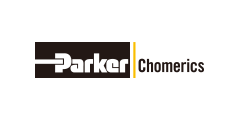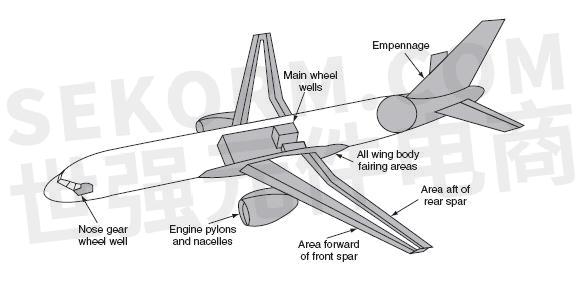Managing EMI and Lightning Strike Protection in Aircraft with CHO-SHIELD® 2002

Composite materials have been replacing metal structures throughout the aircraft industry primarily to save weight, improve fuel economy and reduce costs. But the lack of electrical conductivity in these materials is a disadvantage when compared to the conventional metal airframes of the past.
The conventional, metal airframe allowed designers to take advantage of the natural Faraday cage it formed to protect equipment against interference. There were many opportunities to ground items of equipment reliably by connecting directly to a convenient surface ground.
Today, a typical airframe consists of around 50% composites. Major structures include the fuselage and wing fairing, as well as large sections of the wings, fin and horizontal stabilizers.

Causes of electrical interference
Inside the aircraft there are numerous electrical systems capable of generating EMI which can potentially disturb the operation of critical systems. These include fluorescent lights, light switches, dimming circuits, AC-powered window heaters, motors and generators, data and power cables, and transmitters such as radio and radar.
External storms are also a major source of potentially disruptive electrical interference and can cause physical damage to the aircraft through lightning strike impact.
Recovering lost properties
Replacing metal structures with composites means compromising the EMI shielding and lightning strike protection of the aircraft, as the composites themselves are not electrically conductive. To overcome this issue, woven or non-woven copper-aluminium mesh, or an expanded foil, can be embedded in composite structures to restore lost shielding and grounding properties. The embedded metal provides an optimal combination of electrical conductivity, weight, and corrosion resistance. Solid metal strips can be used in the radome area to handle very high concentrations of lightning energy.
Embedded conductors, however, do not solve all the technical challenges that come with the increasing use of composites. It is very difficult to ensure reliable electrical continuity between individual composite panels after the airframe is assembled and still promote conduction of lightning energy.

Electrical components are typically bonded or grounded directly to the airframe. These connections to the mesh can often fail to meet the very low impedance requirements because of environmental stresses such as vibration and temperature variation. The exposed mesh in the locations where grounded or bonded modules are made (fig 1, at left), can be vulnerable to environmental exposure (temperature, humidity, oxidation) that increases electrical impedance.
Applied performance enhancement
To overcome this challenge, a lightweight coating such as Parker Chomerics CHO-SHIELD technology can be applied to optimize conductivity in this area. CHO-SHIELD® 4994 is a highly conductive, silver-filled polyurethane coating designed for aerospace applications and has superior EMI shielding properties. The coating provides excellent adhesion and wear resistance and is resilient to most operation and environmental fluids. The coating is compatible with many primers and top coat systems.
In areas where high corrosion protection is needed, a copper-based urethane coasting such as Parker Chomerics CHO-SHIELD® 2002 can be used. When used on a composite, CHO-SHIELD 2002 provides the conductivity necessary to achieve excellent shielding effectiveness while maintaining its electrical and mechanical stability in hostile environments. CHO-SHIELD 2002 is designed to be used with Chomerics CHO-SHIELD® 1091 primer to ensure correct adhesion.

The aircraft antennas will also need to be shielded and grounded against lightning strike. This can be achieved by using an expanded woven MetalasticTM EXP-URE gasket material. Electrically conductive grease can be applied at ground connections, to support reliable electrical connectivity under temperature and vibration. Attention must be paid to viscosity and surface-wetting properties when formulating greases for aerospace applications.
Parker Chomerics CHO-LUBE® 4220 has a resistivity better than 100mΩ-cm and is an example of an aerospace-grade grease. It is formulated to support electrical interconnections, improve metal to metal contact and provide long-term oxidation protection for exposed mesh or electrical terminals.
Conductive sealants such as Parker Chomerics CHO-BOND® 2165 or CHO-BOND® 1019 can be applied at locations requiring electrical continuity and environmental protection. Typical airframe areas treated are screw holes, fasteners, antenna connection points and exposed conductors on external areas. Where conductive gaskets are used to promote electrical continuity between composite components, a conductive sealant can be applied to provide improvement in continuity. These areas are generally around the wheel wells, engine mounts, wings and the tail section, where high vibration occurs (figure 2, above).
In addition to these methods which will improve EMI performance throughout the airframe, a lightweight conductive heat shrinkable tube such as Parker Chomerics CHO-SHRINK® 1061 can be used to shield the aircraft’s cabling against the effects of EMI and can provide a weight saving of up to 60% compared to traditional methods.
- +1 Like
- Add to Favorites
Recommend
- On the Cutting Edge: How Parker Chomerics Helps SpaceX Soar
- Sekorm Became an Authorized Distributor of Parker Chomerics
- 5.2W/m-K High Reliability, Fully Cured, Dispensable Thermal Gel from Parker Chomerics
- Advanced Battery Energy Storage Systems (BESS) Solutions: Parker Chomerics 6.0W/m-K THERM-A-FORM CIP 60
- PARKER CHOMERICS New Electrically Conductive Sealant CHO-BOND 1018 Offers Unique Combination: Galvanic Compatibility to Aluminium and Fluid/Fuel Resistance
- Parker Chomerics‘ THERM-A-GAP™ Gel 20 One-component Thermal Interface Material with 2.4W/m-k Thermal Conductivity Ideal for Automotive Industry Applications
- Parker Chomerics THERM-A-FORM CIP 60: 6.0W/m-K Dispensable Thermal Cure-in-Place and Gap Filler Material
- News | Thermal Interface Materials for Challenging Private Spaceflight Applications
This document is provided by Sekorm Platform for VIP exclusive service. The copyright is owned by Sekorm. Without authorization, any medias, websites or individual are not allowed to reprint. When authorizing the reprint, the link of www.sekorm.com must be indicated.





























































































































































































































































































































































































































































































































































































































































































































































































































































































